I’m afraid of the dark. When I was little I’d take a flying leap into my bed so the boogey monster under my mattress couldn’t drag me into his lair. Fast forward 50 years and I’m forced to face my fear on a boat in the middle of an ocean during an offshore passage—sailing about 12 days straight through the night without stopping. That’s a lot of nights. That’s a lot of boogey monsters.
Okay, I don’t really think the boogey monster has followed me to the big, blue ocean. And frankly, sailing at night is beautiful—dark skies illuminate constellations, moon rises are breathtaking, and the solitude of being out here on our own is paradise. When it’s dark, however, you ca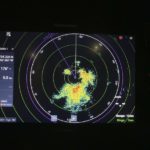 n’t see the container ship that might run into you or know how big that approaching squall is. You have only radar to assess if that Rorschach weather blob is orange, reddish orange, or full on RED—wake the Captain, there’s a serious squall approaching!
n’t see the container ship that might run into you or know how big that approaching squall is. You have only radar to assess if that Rorschach weather blob is orange, reddish orange, or full on RED—wake the Captain, there’s a serious squall approaching!
You have to figure out how cl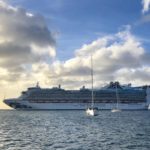 ose is too close for the Carnival Cruise Ship to pass. And what if he’s not paying attention to our little 44-foot radar blob? These gigantic ships have become the boogey monster.
ose is too close for the Carnival Cruise Ship to pass. And what if he’s not paying attention to our little 44-foot radar blob? These gigantic ships have become the boogey monster.
We’re preparing for the 2019 Salty Dawg Rally in Hampton, Virginia, where our first Caribbean adventure began two years ago when we sailed with the rally to Antigua. (Read Destination: Antigua). It’s a delight shopping at Costco and Trader Joe’s and buying all our US favorite treats, as this might be the last time we’re in the US for the foreseeable future.
Our friends, David and Barbara Thomas, are crewing with us to make night watches less sleepless and to keep the boogey monster at bay. We attend safety lectures, meet fellow cruisers, and prepare freezer foods for our passage. We steal the show on Halloween when we dress as the musical group Kiss—complete with wigs and face paint, tossing chocolate kisses to the crowd.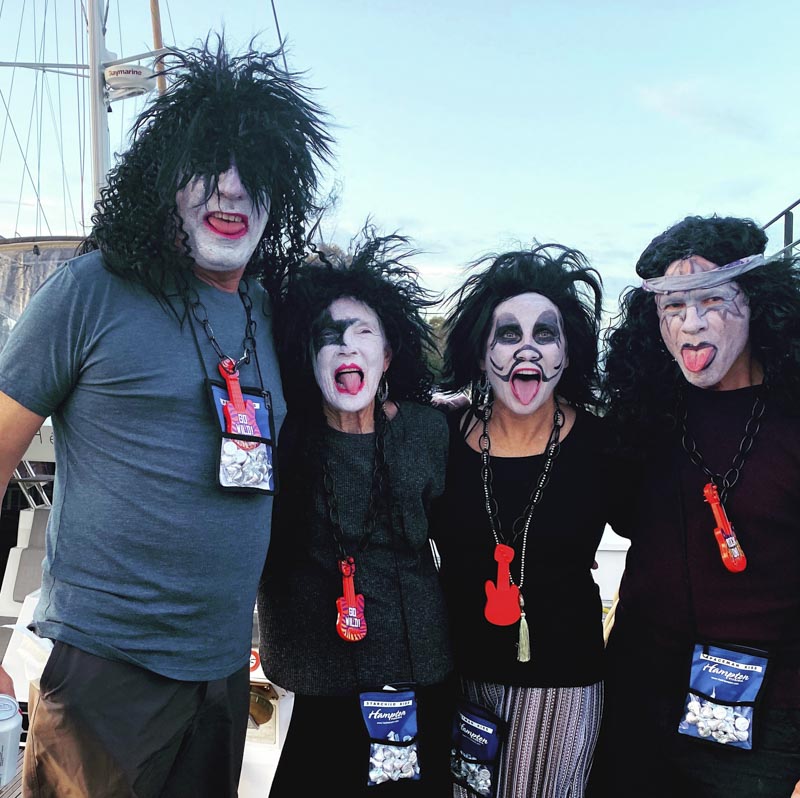
At last, our famed weather router, Chris Parker, gives a tentative go-ahead for our passage—tentative because there’s an offshore cold front headed our direction but the next weather window is at least a week out and nobody really wants that much of a delay. On November 2nd just after 6pm, we join a parade of boats and head into the Chesapeake shipping channel, passing lines of destroyers and aircraft carriers as darkness sets in. Oh goo dy…darkness. Nearly 2,000 miles away is our destination—the island of St. Martin, the very place we met Gémeaux in November 2016.
dy…darkness. Nearly 2,000 miles away is our destination—the island of St. Martin, the very place we met Gémeaux in November 2016.
I lie in bed at 8pm on this first night, trying to convince my body it’s bedtime so I can rest before my watch begins at 4am. We’re all taking 4-hour watches at the helm—David is on 8pm to midnight, Allen takes over until 4am, and then Barbara and I share a watch until 8am. Despite the early hour, I like our watch because half of it will be in the light when all boogey monsters sleep. During the day, we alternate who’s at the helm, giving each other a break to sleep or read or prepare food. I’m restless and wide-eyed. The boat pitches and rolls through the open sea, waves pound against the hulls, and the helm is just above my bed so I hear all the sail adjustments. Somehow I must have dozed off because my 3:45am alarm jars me from sleep. I put on my life jacket and adjust my eyes to the surrounding darkness—interior lights are off to improve our night vision. Barbara and I make cocoa and take over watch from Allen, who gives us a quick debrief of our current course, weather, and any nearby traffic. At this early stage in our passage, there are a few rally boats nearby. Soon, we will all disperse and find our own path on this marine highway to the Caribbean. We’re instructed to wake the captain if vessels get within three miles of us, a squall approaches, or if the wind increases, decreases, or shifts. Gee, what are the odds of none of that happening during the next four hours? Nevertheless, we want the captain to get his rest so we keep our fingers crossed for an uneventful watch and constantly second guess our decisions before waking him. We’re a ¼ mile off course—is that enough to wake the captain? Should we wait until it becomes ½ mile? ¾ of a mile? It doesn’t really matter—Allen wakes at the slightest shift in wind and sleeps with one eye closed and the other on his iPhone, which has remote access to the chart plotter. He always knows what we’re doing and sometimes I think he just lies down there testing us to see when we’ll wake him. 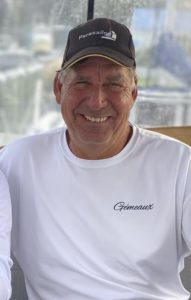 Tonight…er this morning, after motoring since we left the marina, Allen pops up from bed with a big grin and announces The wind is up—raise the sails and turn off the engines! There is nothing that makes the captain happier.
Tonight…er this morning, after motoring since we left the marina, Allen pops up from bed with a big grin and announces The wind is up—raise the sails and turn off the engines! There is nothing that makes the captain happier.
My eyelids are heavy and I watch the clock slowly tick to 8am when David will take over. This is the other problem I have with passages—I just can’t stay awake. The constant motion of the boat puts me immediately to sleep and, unlike my partner, I do need sleep…lots of it. It helps having a second person to share the watch—Barbara and I swap tales of motherhood, share our different adventures around the planet, review books, discuss how to adjust passage meals for both hungry and sick tummies, and solve the problems of the world. We study the chart plotter an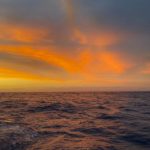 d quiz each other on all its features, becoming experts on the difference between apparent and true wind speed and how to trim the sails. I make stovetop popcorn, a food my friend, Courtney, introduced as the perfect passage treat. We perk up at the first glimpse of daybreak and celebrate each sunrise.
d quiz each other on all its features, becoming experts on the difference between apparent and true wind speed and how to trim the sails. I make stovetop popcorn, a food my friend, Courtney, introduced as the perfect passage treat. We perk up at the first glimpse of daybreak and celebrate each sunrise.
Both Barbara and I love the natural world and enjoy being quiet witnesses to the details of how a day begins. Free of noise and distractions, we realize the complete sunrise takes nearly 45 minutes. With our panoramic view of the sky, we watch the moon set and the sun rise and are tickled when they happen simultaneously. We notice how colors evolve from black to purple to fiery reds and oranges. And when at long last, the sun rises, we break the silence and declare the dawn of a new day…and nearly the end of our watch. David greets us with a big smile and coffee in hand. We pass the baton and I immediately return to bed. My body ignores the boat din and sleep comes easily.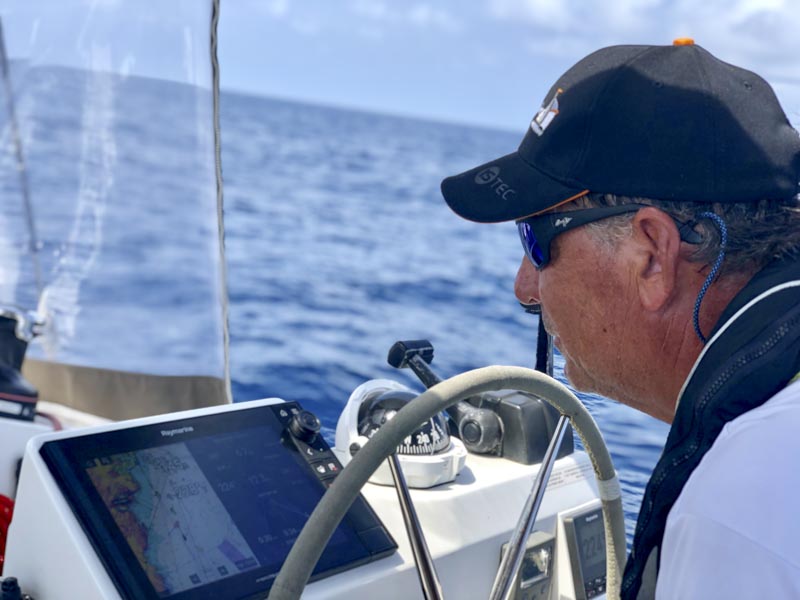
By 2pm the following day, we reach the Gulf Stream where the water temperature jumps from the low 60s to a balmy 75 degrees. We’re anxious to shed our jackets and layers of warm clothing. Before long, the rain flaps that create our protective cocoon at the helm won’t be necessary. We’ll stow the down comforters from our beds and open the hatches. We’ll start complaining of hot, sweaty nights and long for that cool sleeping weather we had just days ago. Still, I love this gradual transition to the Caribbean climate.
I have a long list of what I plan to accomplish during our offshore passage. Nearly two weeks when the world stops and I can catch up on writing and various boat projects. Immediately, however, as we bounce through a boisterous (as our British friends would say) Gulf Stream with 8-10 foot waves, I realize none of it will be done. Instead, my days will consist of two activities—1) a 4-8am watch and 2) sleep. I hadn’t planned on being sea sick. Yup, an occupational hazard.
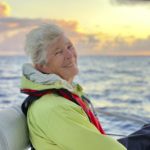 Allen never gets sea sick and David and Barbara both are wearing Scopolamine patches that appear to be working well from them. I’ve tried several different medications over the years and the sleepiness and other side effects are almost worse than the sea sickness itself. I choose to just grin and bear it and hope I get my sea legs soon. That strategy sounded good until I ended up hanging my head over the back of the boat. Finally on day five, I break down and become a patcher. I’m sleepy and feel jittery like I’m going through some type of detox. My mouth is full of cotton that no drink can cure. But…I’m not nauseous.
Allen never gets sea sick and David and Barbara both are wearing Scopolamine patches that appear to be working well from them. I’ve tried several different medications over the years and the sleepiness and other side effects are almost worse than the sea sickness itself. I choose to just grin and bear it and hope I get my sea legs soon. That strategy sounded good until I ended up hanging my head over the back of the boat. Finally on day five, I break down and become a patcher. I’m sleepy and feel jittery like I’m going through some type of detox. My mouth is full of cotton that no drink can cure. But…I’m not nauseous.
Today after my watch, I sleep until 11am. I feel almost normal when I wake, except these 24-hour days leave my stomach confused. I’m not sure if I should prepare breakfast or lunch. Pringles and Top Ramen are my favorite sea sickness menu items. There is no food shaming here. I fix Allen his typical breakfast of pineapple and peanut butter toast, knowing his fresh pineapple days are numbered.
I notice the fishing lines are out. David wants to fish and he really wants to eat fresh mahi mahi. I’m conflicted. I like fish dinners too but right now I’m sure the smell of fish would put my head right back over the stern. Plus, I love the sea and I’m finding it increasingly more difficult to kill its lovely inhabitants. For now, it’s catch and release.
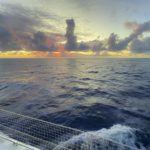 I listen to my Audible book since I can’t read without getting nauseous. Sapiens: A Brief History of Humankind gives me a lot to contemplate on these long days with only three other sapiens. I decide on chicken enchiladas for dinner and chips and guacamole before the avocados rot. Fresh vegetables are so precious and I hate the thought of letting any of them go bad. People come and go between sleep, a shower, reading, and eating some kind of meal that can’t be defined. Allen and I take down the main sail and roll up the jib admitting defeat from lack of wind. My novice sailing opinion is there’s never the right amount wind—too little or gale force, never just right for Goldilocks. David offers to prep dinner and I’m relieved to just sit and have someone else be the galley slave.
I listen to my Audible book since I can’t read without getting nauseous. Sapiens: A Brief History of Humankind gives me a lot to contemplate on these long days with only three other sapiens. I decide on chicken enchiladas for dinner and chips and guacamole before the avocados rot. Fresh vegetables are so precious and I hate the thought of letting any of them go bad. People come and go between sleep, a shower, reading, and eating some kind of meal that can’t be defined. Allen and I take down the main sail and roll up the jib admitting defeat from lack of wind. My novice sailing opinion is there’s never the right amount wind—too little or gale force, never just right for Goldilocks. David offers to prep dinner and I’m relieved to just sit and have someone else be the galley slave.
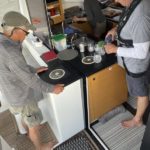 Allen cheerfully pours cocktails—club soda over 2 ice cubes per person (another precious commodity) and a splash of tonic with lime that we’ve dubbed and tonics. We’re always a dry boat on passages so gin won’t return to our and tonics until we reach land. We enjoy dinner together around the cockpit table now that’s it’s warm enough to once again eat outside. An overcast day presents a lovely sunset with clouds all around. Allen joins a 6:30pm radio broadcast on weather while David cleans up and Barbara and I manage the helm. We are falling into roles and intuitively prepare for another round of night watches. Navigation lights come on, screens and gauges are turned to dark mode, and I find my headlamp and wool hat—the night wind is still cool on my head. We all remark how much we love when the sails are up and we’re going fast and bouncing around…while it’s light. The minute we’re engulfed in darkness, the mood becomes somber, things are scary. What’s that light on the horizon? How far away is the lightening? Is the wind too much for the sails? The boogey monster returns.
Allen cheerfully pours cocktails—club soda over 2 ice cubes per person (another precious commodity) and a splash of tonic with lime that we’ve dubbed and tonics. We’re always a dry boat on passages so gin won’t return to our and tonics until we reach land. We enjoy dinner together around the cockpit table now that’s it’s warm enough to once again eat outside. An overcast day presents a lovely sunset with clouds all around. Allen joins a 6:30pm radio broadcast on weather while David cleans up and Barbara and I manage the helm. We are falling into roles and intuitively prepare for another round of night watches. Navigation lights come on, screens and gauges are turned to dark mode, and I find my headlamp and wool hat—the night wind is still cool on my head. We all remark how much we love when the sails are up and we’re going fast and bouncing around…while it’s light. The minute we’re engulfed in darkness, the mood becomes somber, things are scary. What’s that light on the horizon? How far away is the lightening? Is the wind too much for the sails? The boogey monster returns.
Since our departure, we’ve been chased by a strong cold front that now stretches from Bermuda to the Bahamas, just as our weather router predicted. We’ve been able to stay ahead of the front but even 100 miles behind us we can feel its effects—bands of fierce squalls with intense downpours, usually escorted by high winds. After several years in the Caribbean we’ve seen our share of squalls. Most pass pretty quickly except for that one in the Bahamas when nearly 50 knot winds ripped our main sail from the mast. (Read Squall!) That squall has always been unique until now. Today we’ve had three! squalls with extended winds above 40 knots accompanied with a deluge of rain. Sitting at the helm is like being sprayed with a fire hose. Unlike the Bahamas squall; however, we’re prepared and Gémeaux stays in tact.
After dinner, I prepare for bed while Allen and David battle weather, taking down sails and altering course to avoid squalls and lightening. I take a quick shower wiping away days that have run together and it feels good. At 9:30, I fall into bed where the air is hot but I’m desperate to find sleep before another passage day begins. Minutes after my head hits the pillow, Allen wakes me. Every instrument on the boat is dead. The chart plotter that holds all our data, maps, route, weather, radar, EVERYTHING has crashed. The auto pilot that steers the boat is not functioning. All gauges are black. Of course it’s night and pitch black outside…when all disasters occur. And, it’s raining. Our first thought is that we’ve been struck by lightning. But while lightning is visible, no strikes are close to us. We are basically blind—no sight and no radar—and we’re chained to the helm hand steering to a compass.
The upside? We expect failures like this and carry a million spare parts. We have the right part to get the boat’s electronic network functional, but first we have to determine the source of the problem. Our captain brilliantly identifies the issue in the first place he looks. The fuse for the network has blown. No problem—just replace it. Then, the replacement fuse blows as well. Seems we have only a few spare fuses—not a million:( so we’re careful not to waste them. We track the problem down to the helm station—the deluge of rain appears to have shorted the instruments inside bringing down the entire network. The captain jury-rigs a spare autopilot controller into the system, which allows us to use the autopilot through the night. Tomorrow, when daylight arrives and the boogey monster sleeps, we’ll research further. I can hardly wait until my watch begins in a few hours!
When morning arrives, the captain works his magic and gauges, electronics, and autopilot continue working for the final few days as we close in on our destination. Now less than 400 miles away, it’s exciting to see land appear on the chart plotter and we eagerly await that first glimpse of dirt on the horizon. Winds again are light and our fuel capacity even lighter. We’ve been waiting for the trade winds to give us a swift sail the remaining distance but they seem just out of grasp. We pass the mark on the chart plotter where two years ago our underwater escape hatch failed and we drifted during the night while our adhesive repair set. Even though this passage has delivered continuous lines of squalls each night, I’m relieved we’re not dealing with a failing hatch. Confident as I am in Allen’s hatch repair, though, I still can’t help checking it each time I pass by it. Damn hatch. (Read Escape Hatches-Recipe for Disaster.)
The pineapple is gone. Books have been read. We miss the Internet…sort of. We just want to be there. And just like that…that trade winds arrive. Warm and strong boosting our speed to 7-8 knots. The captain is very happy. Barbara and I take our final watch together.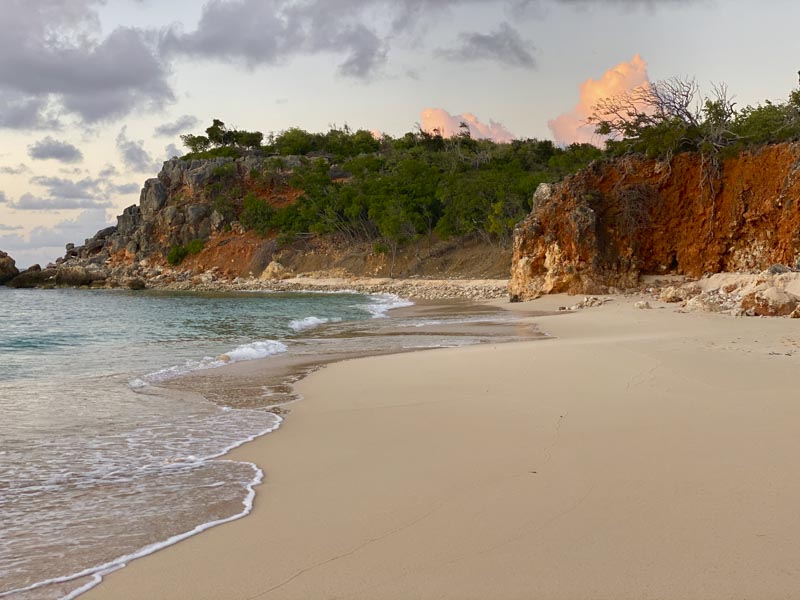 The next waypoint on the chart plotter is LAND! Our eta for the island of Tintemarre off St. Martin is 5am the following day. The skies present a celebratory sunrise that paints the entire eastern horizon orange. A school of 10 dolphins playfully weave between our hulls, completing the festive spirit. A bird flies overhead. Time to chill the champagne.
The next waypoint on the chart plotter is LAND! Our eta for the island of Tintemarre off St. Martin is 5am the following day. The skies present a celebratory sunrise that paints the entire eastern horizon orange. A school of 10 dolphins playfully weave between our hulls, completing the festive spirit. A bird flies overhead. Time to chill the champagne.
1896 miles
12 days
0 boogey monsters
Enjoyed this post?
Sign up at the bottom of this page
to receive email notifications of future posts!



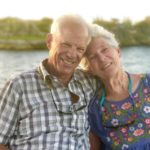

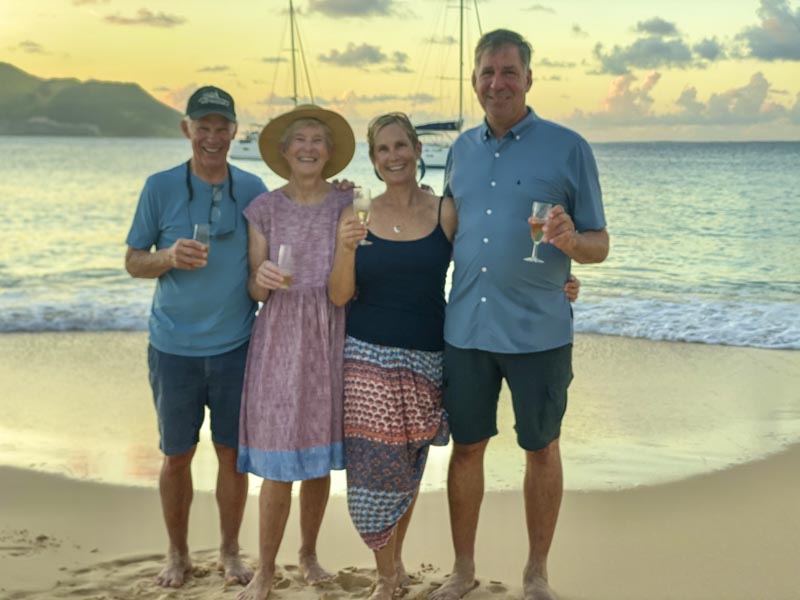
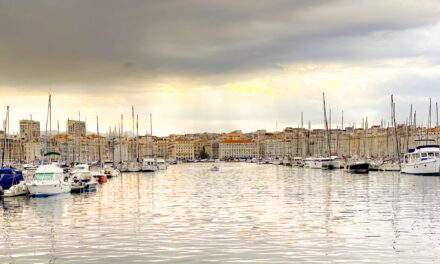
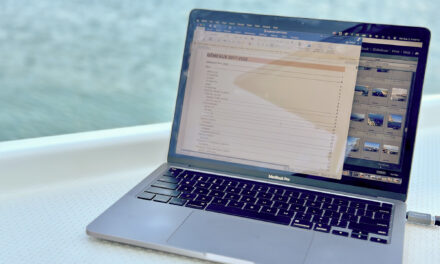
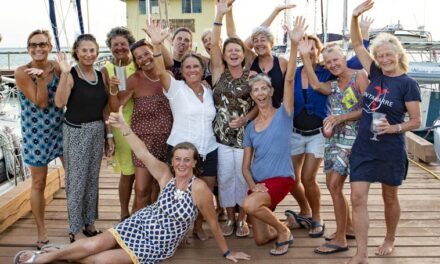
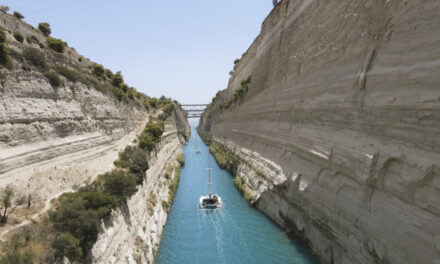


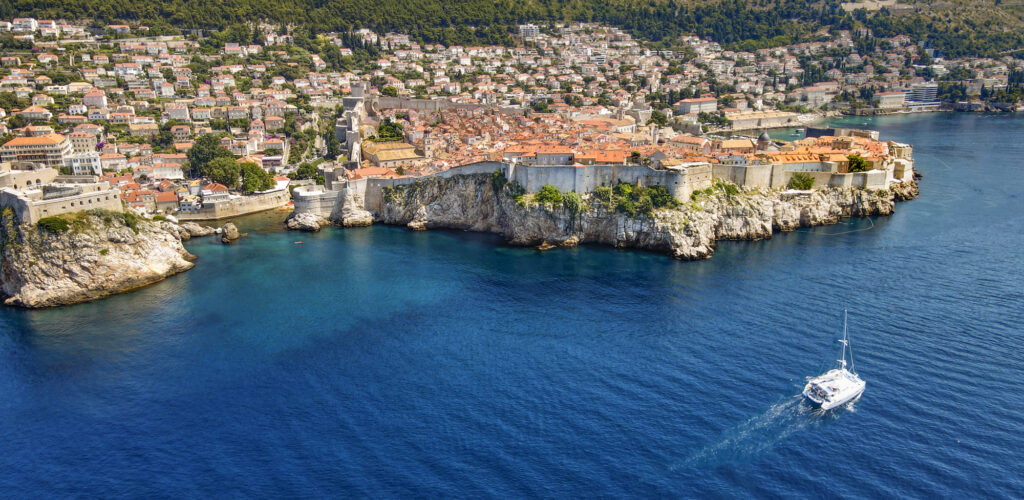
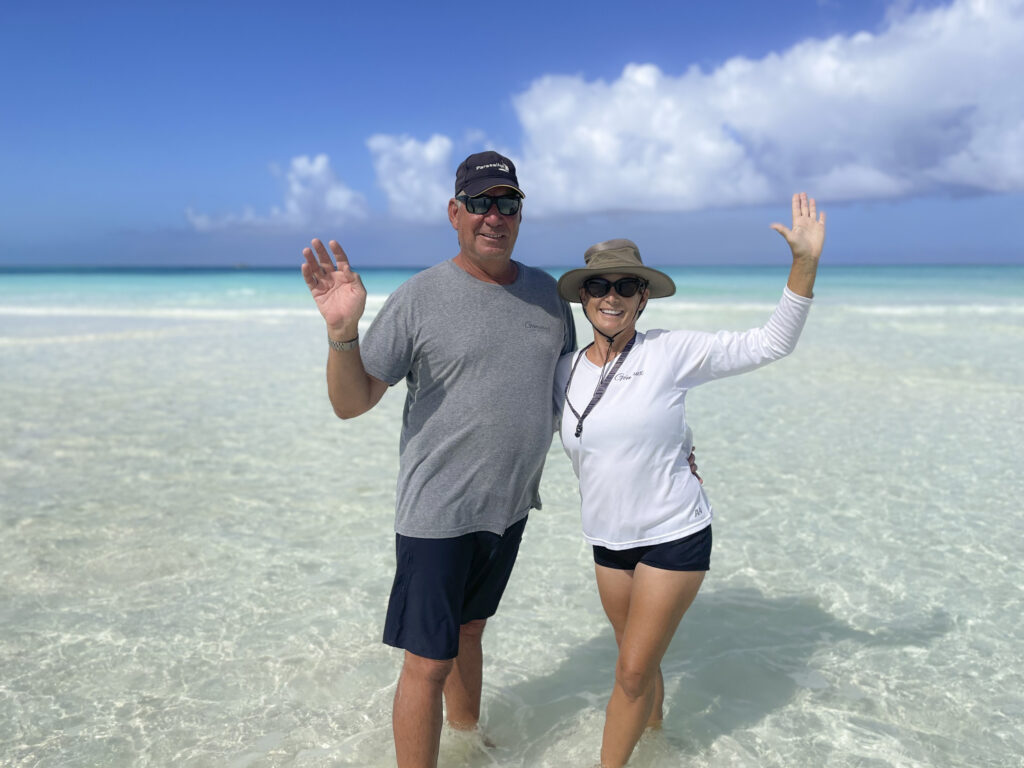
Your narrative is spellbinding and great fun to read! Do I see a book somewhere down the road (or on the sea)?
Ah thanks and yes, definitely a book!
Love reading about your adventures. What a journey!! Miss you and safe travels!! Hugs!
Great writing Shiera! I felt like I was there with you.